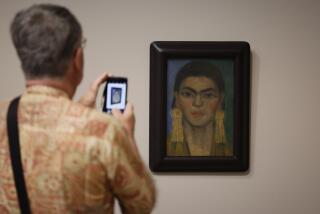Review: ‘Portrait of Wally’ explores a fascinating odyssey
- Share via
It’s a small painting as paintings go, quite demure by the salacious standards of its artist, but, oh, the fuss it caused.
As detailed in Andrew Shea’s fascinating documentary “Portrait of Wally,”Egon Schiele’s haunting 1912 painting of his mistress and favorite model Wally Neuzil had a complicated, extremely dramatic history as well as a legal and cultural significance that can’t be overestimated.
The battle to return this heartfelt painting — half of a de facto artist and model double portrait — to the family of the woman who originally owned it jump-started the current international art restitution movement that reunites misappropriated objects with their original owners.
The artist would have been surprised to learn that this particular painting would become the center of a major art world controversy that played out over 13 years. The immediacy, rawness and sexuality of his work led the Austrian authorities of Schiele’s day to consider it next to pornographic.
Schiele’s major supporter was his dealer, a woman named Lea Bondi, and she so loved “Portrait of Wally” that she bought it herself and kept it not in her Vienna gallery but in her home.
However, when the 1938 Anschluss joined Austria to Nazi Germany and all Jewish-owned businesses were Aryanized, their goods confiscated by the Nazis and given to deserving party members, the man who claimed Bondi’s gallery went to her house and expropriated the portrait, forcing Bondi to sell it for a pittance.
After the war, Bondi managed to get her gallery back but discovered, to her shock and horror, that the Wally portrait, which a relative says “was like her child,” had been erroneously repatriated — either through honest mistake or more likely callous ploy — not to her but to Austria’s National Gallery.
Desperate to recover the portrait, Bondi turned to a man she thought was a friend, fellow Schiele enthusiast Rudolph Leopold. But Leopold turned out to be such an obsessive collector that once he maneuvered the painting out of the National Gallery, he decided to keep it for himself as the cornerstone of his own collection, which eventually became the Leopold Museum.
The more contemporary part of the Wally story starts in 1997, when New York’s Museum of Modern Art opened an exhibit titled “Schiele: The Leopold Collection,” which featured the Wally portrait.
When a New York Times reporter revealed the past in an article, it led Henry Bondi, Lea Bondi’s American nephew, to file a claim for the painting, describing a history of “injustice upon injustice upon injustice.” His plea moved Dist. Atty. Robert Morgenthau.
“The painting was about to return to Austria,” he says in the film. “We threw a Hail Mary pass at the eleventh hour,” issuing a warrant on behalf of the heirs that prevented the painting from leaving the country. Which is where things got really interesting.
As described in absorbing detail by many speakers in Shea’s film, Morgenthau’s decision convulsed the art world. It horrified the Museum of Modern Art, which feared that if art were seized, even for the best of reasons — i.e. it had been stolen — it would have a chilling effect on the willingness of museums in other countries to lend to the United States.
Such was the clout of MOMA and its powerhouse board of directors that all kinds of institutions and individuals, even the Jewish Museum, lined up behind it. That group included the wealthy Ronald Lauder, who had previously founded the Commission for Art Recovery and called paintings like the Schiele “the last prisoners of war.”
On one level, the story of this painting should have been the simple one of a great work of art returned to its rightful owners. By showing how difficult and problematic righting a wrong can turn out to be, “Portrait of Wally” does itself proud.
More to Read
Only good movies
Get the Indie Focus newsletter, Mark Olsen's weekly guide to the world of cinema.
You may occasionally receive promotional content from the Los Angeles Times.











